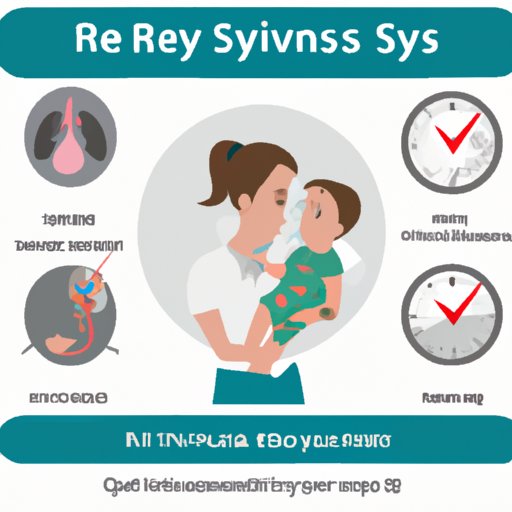
Introduction
RSV or Respiratory Syncytial Virus is a viral infection that can occur in people of all age groups. It is especially common in infants, young children, and older adults. The virus causes respiratory illnesses ranging from common cold-like symptoms to bronchiolitis and pneumonia. Understanding the duration of RSV symptoms is crucial in managing the illness properly and avoiding complications.

A Comprehensive Guide to RSV Symptoms and Its Duration
RSV symptoms can vary from person to person. In infants and young children, the symptoms may seem like a cold with a runny nose, cough, and fever. In older adults and people with weakened immune systems, the infection can be severe and lead to more serious respiratory illnesses. It is important to differentiate RSV from other respiratory illnesses such as flu and COVID-19, as the management and treatment can vary. It is recommended to seek medical attention if symptoms persist or worsen.
From Start to Finish: Understanding the RSV Symptom Timeline
RSV symptoms typically appear within four to six days of exposure to the virus. Symptoms can last for up to two weeks, but in some cases, they may persist for several weeks.
Breaking Down the Lifespan of RSV Symptoms
RSV symptoms generally occur in three stages: the early stage, the advanced stage, and the recovery stage. Each stage can last for different durations, and understanding the timeline can help manage the illness properly.
Stages of RSV Symptoms: What to Expect and When
The early stage of RSV symptoms includes symptoms such as a runny or blocked nose, cough, sneezing, and a sore throat. These symptoms typically last for 3 to 4 days.
The advanced stage of RSV symptoms includes lower respiratory tract symptoms such as wheezing, chest tightness, and difficulty breathing. These symptoms typically last for 3 to 7 days.
Common complications from RSV include ear infections and pneumonia, which can lead to further symptoms and prolonged illness duration.
RSV Symptoms: How Long Before Relief?
The duration of RSV symptoms can vary depending on factors like age, medical history, and general health. There are no specific treatments for RSV, but management of symptoms can help relieve discomfort and speed up recovery. Treatment may include over-the-counter medications for fever and pain or prescription medications for more severe symptoms. Generally, most people can expect relief from their symptoms within two weeks.
Navigating the Duration of RSV Symptoms: Tips and Tricks
At-home management of RSV symptoms can be effective in relieving discomfort and speeding up recovery. Drinking plenty of fluids, resting, and staying in a humid atmosphere can help ease coughing and congestion. In severe cases, hospitalization may be necessary for proper respiratory support.
If symptoms persist or worsen, it is crucial to seek help from a medical professional who can provide relevant testing and monitoring.
From Days to Weeks: Unpacking How Long RSV Symptoms Last
RSV symptoms can last for several weeks in some cases, especially in infants, young children, and the elderly. The duration of symptoms can be influenced by factors such as immune status, underlying medical conditions, and environmental factors. It is essential to follow guidance from medical professionals to manage symptoms properly, avoid complications, and speed up recovery.
Conclusion
RSV symptoms can vary in duration and severity. Understanding the timeline of symptoms can help manage the illness properly and avoid further complications. It is important to seek medical attention if symptoms persist or worsen. At-home management of RSV symptoms can be effective, but it is essential to follow guidance from medical professionals for proper monitoring and treatment.


